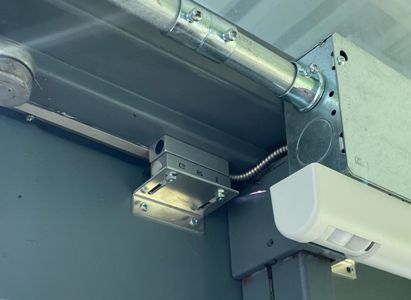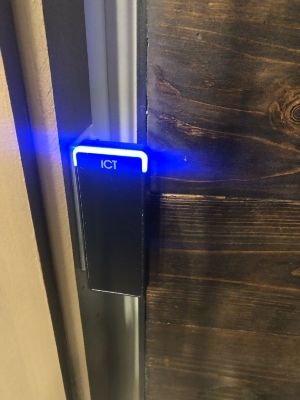Video MGMT System
 Access Control
Access Control
Voice & Data Wiring
 Burglar Alarm
Burglar Alarm
 Fire Alarm
Fire Alarm
Video MGMT System
Voice & Data Wiring
An access control policy defines how resources, such as physical facilities, devices, and digital data, can be accessed and used.
When designing an access control policy, define the authentication and authorization mechanisms that limit individual users' access to restricted resources.
Access control authorization methods limit access to resources in a physical location, network, or application.

An access control policy should define the physical controls restricting access to facilities and resources. For example, security gates and locks are physical controls that ensure only authorized individuals enter secured areas.
Cloud access control is an access control model that keeps software and collected data in the cloud and provides centralized management tools that are conveniently accessible for remote access. This approach avoids the expense of an on-site server (a requirement for non-web-based and non-cloud-based access systems).
Device access controls are used to manage access to devices such as laptops, smartphones, and tablets. Your policy should define the security measures that need to be in place, such as encryption.
Digital access controls manage access to digital data, such as security camera surveillance files, databases, and networks. An access control policy should define the authentication and authorization mechanisms required to ensure that only authorized users can access digital data. Digital access controls include secure encryption and data management policies.

The first step in setting up an effective access control policy is identifying the resources that need protection, such as files, databases, servers, and applications.
Once the resources have been identified, the next step is to identify the devices that will be used to access these resources. This includes laptops, desktops, smartphones, and tablets.
Identify the users who will be accessing the resources. Employees, contractors, partners, and guests or customers using visitor management systems may be included.
An access control policy should define the risk assessment process and the measures that need to be taken to mitigate identified risks. This involves identifying potential security threats, such as cyber-attacks or data breaches, and determining the impact they could have on the organization.
Once devices, users, and risks have been identified, the next step is to determine the access requirements for each user and device. This includes defining the level of access required, such as read-write access or access only during specific times, and the resources each user and device can access.
An access control policy should define the security policies required for each device or user, such as password policies, encryption policies, and device management policies.
Configuring security policies for each device or user is essential to ensure they have the appropriate level of access and security controls in place.
Implementing access control includes defining authentication mechanisms, such as passwords or biometric readers, and authorization mechanisms, such as role-based access controls or attribute-based access controls.
Assigned permissions determine the level of access a user or device has to particular resources.
By following the following guidelines, organizations can ensure that their resources are protected from unauthorized access.

Access control types and levels should be defined based on user roles and responsibilities. Examples of access types and levels include read-only, read-write, physical access, and administrative access.
A hierarchical structure of permissions ensures that access is granted based on the user's position within the organization. The policy should clearly define who has access to which resources and at what level so that employees only have access to the resources they need to perform their job responsibilities.
Rules should be developed around password policies, data encryption, and authentication methods. This includes setting minimum password requirements, using encryption to protect sensitive data, and implementing strong authentication methods.
File and folder restrictions should be tailored to comply with industry regulations and organizational policies. This includes ensuring that access to sensitive data is limited and that permissions are regularly reviewed and updated in accordance with policies and regulations.
Applying an access control policy involves tailoring policies to specific business objectives and testing customized rules before launching them.

Policies should be designed to protect the most critical assets, sites, and data of an organization first. For example, if an organization is focused on protecting sensitive customer data, the policies related to accessing that data should be given the highest priority.
Custom access control policies should be thoroughly tested before they are launched into production. This involves using a testing environment to simulate various scenarios and ensure that the policies are working as intended.
An intrusion prevention system (IPS) is a security solution that monitors network traffic to detect and prevent potential security threats. This is achieved through a combination of signature-based and behavior-based detection methods, which allow the IPS to identify and block known threats as well as new or unknown threats.

Utilizing automation for your access control policy can provide real-time alerts, continuous monitoring, scalability, data analysis, and reduced workload for security teams. By using automated monitoring and access control systems, organizations can improve their overall security posture and respond more effectively to potential security threats.
Creating a robust access control policy is vital for protecting your organization's resources, data, and facilities from unauthorized access. Prioritizing policy rules based on business objectives, testing customized rules, and utilizing automation for easier monitoring are crucial steps to ensure a secure and efficient access control system. It may be helpful for you to see access control policy examples that you could use for your system.
To learn more about access controls, implementing access control systems in your business, and safeguarding your assets, don't hesitate to contact Mammoth Security. Our team of experts is ready to help you design and implement a tailored access control policy that meets your organization's unique needs.
NOT COMPLETELY SURE?
860-748-4292